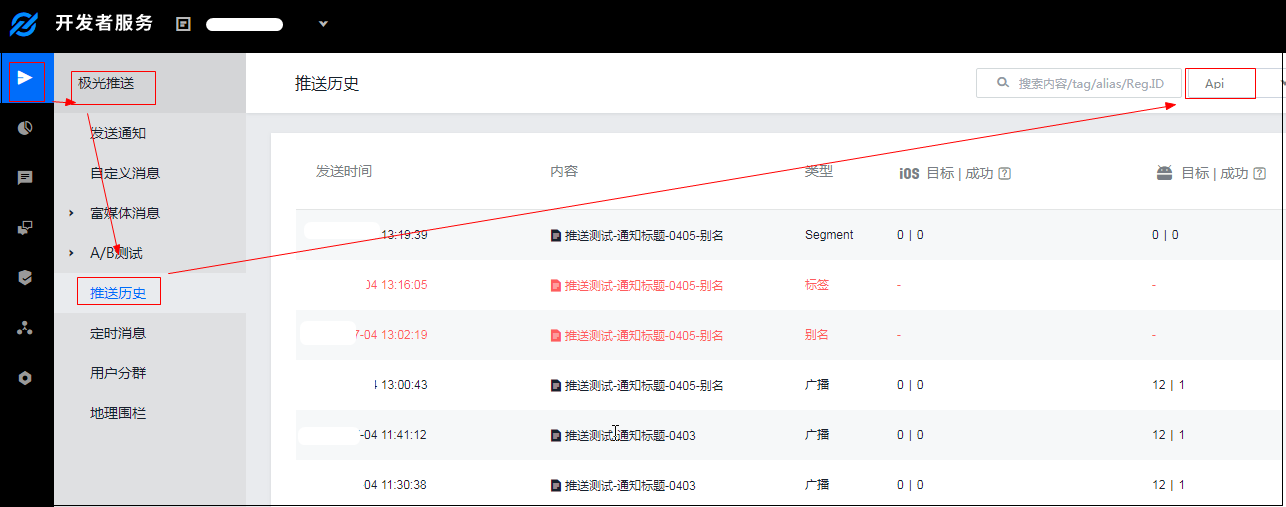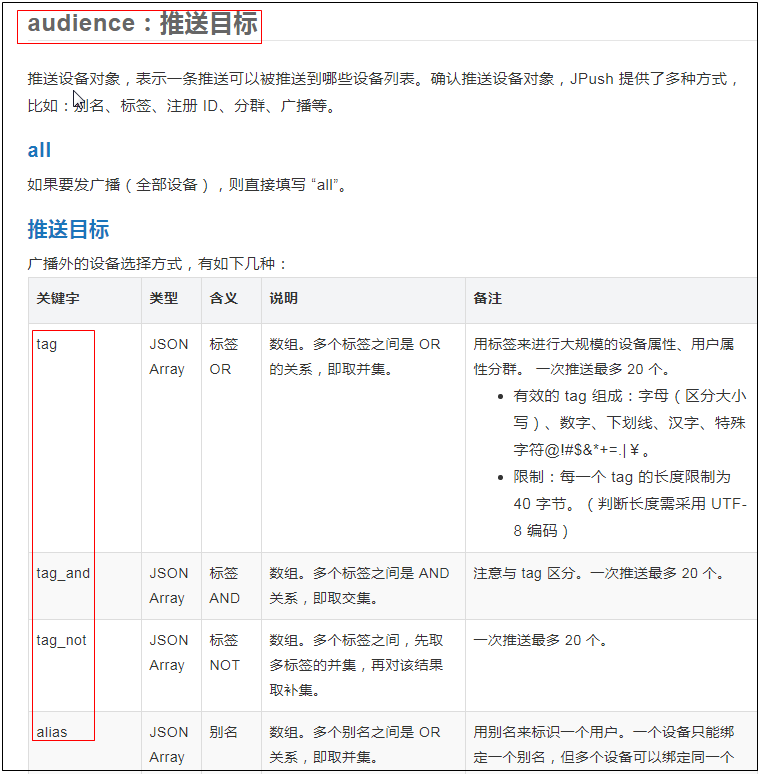java服务端集成极光消息推送--详细开发步骤
1.极光推送账号准备
要使用极光消息推送必须先在官方网站上注册账号,并添加应用.
产品介绍:https://docs.jiguang.cn/jpush/guideline/intro/
注册开发者账号:https://www.jiguang.cn/accounts/register
注册完成后需要添加应用
应用配置好后有两个重要的数据,必须获取到,在后面发送消息的时候要使用:

2.极光推送后端管理配置认识
要做极光推送,得先认识极光账号的后端管理平台,应为在开发的时候很多参数和配置来自于后端管理系统
先宏观认识一下消息推送流程图:

后端管理说明:https://docs.jiguang.cn/jpush/console/Instructions/
3.集成java服务端
3.1.添加maven依赖,使用官方提供的sdk
1 <!-- 极光推送 --> 2 <dependency> 3 <groupId>cn.jpush.api</groupId> 4 <artifactId>jpush-client</artifactId> 5 <version>3.3.12</version> 6 </dependency>
3.2.客户端java代码
代码参考文档:
https://docs.jiguang.cn/jpush/server/push/server_overview/

1 package com.qianxingniwo.client; 2 3 4 import cn.jpush.api.JPushClient; 5 import cn.jpush.api.push.PushResult; 6 import cn.jpush.api.push.model.Message; 7 import cn.jpush.api.push.model.Options; 8 import cn.jpush.api.push.model.Platform; 9 import cn.jpush.api.push.model.PushPayload; 10 import cn.jpush.api.push.model.audience.Audience; 11 import cn.jpush.api.push.model.notification.AndroidNotification; 12 import cn.jpush.api.push.model.notification.Notification; 13 import org.slf4j.Logger; 14 import org.slf4j.LoggerFactory; 15 16 import java.util.ArrayList; 17 import java.util.List; 18 19 /** 20 * @Copyright (C) 四川千行你我科技有限公司 21 * @Author: LI DONG PING 22 * @Date: 7/3 19:11 23 * @Description: 24 */ 25 26 public class JpushClientUtil { 27 private static final Logger log = LoggerFactory.getLogger(JpushClientUtil.class); 28 29 private final static String appKey = "应用的key(非登录账号)"; 30 31 private final static String masterSecret = "应用的密码(非登录密码)"; 32 33 private static JPushClient jPushClient = new JPushClient(masterSecret, appKey); 34 35 36 /** 37 * 发送给所有安卓用户 38 * 39 * @param notification_title 通知内容标题 40 * @param msg_title 消息内容标题 41 * @param msg_content 消息内容 42 * @param extrasparam 扩展字段 43 * @return 0推送失败,1推送成功 44 */ 45 public static int sendToAllAndroid(String notification_title, String msg_title, String msg_content, String extrasparam, String cid) { 46 int result = 0; 47 try { 48 PushPayload pushPayload = JpushClientUtil.buildPushObject_android_all_alertWithTitle(notification_title, msg_title, msg_content, extrasparam, cid); 49 System.out.println("推送参数:" + pushPayload); 50 PushResult pushResult = jPushClient.sendPush(pushPayload); 51 System.out.println("推送结果:" + pushResult); 52 if (pushResult.getResponseCode() == 200) { 53 result = 1; 54 } 55 } catch (Exception e) { 56 57 e.printStackTrace(); 58 } 59 60 return result; 61 } 62 63 /** 64 * 生产发送条件 65 * 66 * @param notification_title 67 * @param msg_title 68 * @param msg_content 69 * @param extrasparam 70 * @param cid 71 * @return 72 */ 73 private static PushPayload buildPushObject_android_all_alertWithTitle(String notification_title, String msg_title, String msg_content, String extrasparam, String cid) { 74 log.info("构建推送参数,如推荐平台,接收对象"); 75 //具体参看接口文档 76 //https://docs.jiguang.cn/jpush/server/push/rest_api_v3_push/ 77 List list = new ArrayList(); 78 // Audience.tag(list); 79 // Audience audience = Audience.alias("112201","112202");//别名推送 80 // Audience audience = Audience.tag("tag1"); 81 //Audience audience = Audience.all(); 82 // Audience audience = Audience.registrationId("112201", "112202"); 83 Audience audience = Audience.segment("c8f2fff736"); 84 return PushPayload.newBuilder() 85 //指定要推送的平台,all代表当前应用配置了的所有平台,也可以传android等具体平台 86 .setPlatform(Platform.android()) 87 //设置发送消息id 88 // .setCid(cid) 89 //指定推送的接收对象,all代表所有人,也可以指定已经设置成功的tag或alias或该应应用客户端调用接口获取到的registration id 90 .setAudience(audience) 91 // .setAudience(Audience.tag(list)) 92 //jpush的通知,android的由jpush直接下发,iOS的由apns服务器下发,Winphone的由mpns下发 93 .setNotification(Notification.newBuilder() 94 //指定当前推送的android通知 95 .addPlatformNotification(AndroidNotification.newBuilder() 96 .setAlert(notification_title) 97 .setTitle(notification_title) 98 //此字段为透传字段,不会显示在通知栏。用户可以通过此字段来做一些定制需求,如特定的key传要指定跳转的页面(value) 99 .addExtra("androidNotification extras key", extrasparam) 100 .build()) 101 .build() 102 ) 103 //Platform指定了哪些平台就会像指定平台中符合推送条件的设备进行推送。 jpush的自定义消息, 104 // sdk默认不做任何处理,不会有通知提示。建议看文档http://docs.jpush.io/guideline/faq/的 105 // [通知与自定义消息有什么区别?]了解通知和自定义消息的区别 106 .setMessage(Message.newBuilder() 107 .setMsgContent(msg_content) 108 .setTitle(msg_title) 109 .addExtra("message extras key", extrasparam) 110 .build()) 111 112 .setOptions(Options.newBuilder() 113 //此字段的值是用来指定本推送要推送的apns环境,false表示开发,true表示生产;对android和自定义消息无意义 114 .setApnsProduction(false) 115 //此字段是给开发者自己给推送编号,方便推送者分辨推送记录 116 .setSendno(1) 117 //此字段的值是用来指定本推送的离线保存时长,如果不传此字段则默认保存一天,最多指定保留十天,单位为秒 118 .setTimeToLive(86400) 119 .build()) 120 .build(); 121 } 122 123 /** 124 * 发送测试 125 * 126 * @param args 127 */ 128 public static void main(String[] args) { 129 String num = "-0405-别名"; 130 String notification_title = "推送测试-通知标题" + num; 131 String msg_title = "推送测试-内容标题" + num; 132 String msg_content = "我是内容" + num; 133 String extrasparam = "我是扩展的json" + num; 134 String cid = String.valueOf(System.currentTimeMillis()); 135 int i = JpushClientUtil.sendToAllAndroid(notification_title, msg_title, msg_content, extrasparam, cid); 136 System.out.println("i=" + i); 137 } 138 }
3.3.发送测试
执行发送后,如果发送成功,我们可以在后端管理系统中看见消息详情

3.3.注意事项
1.刚建立的极光账号由于配置的原因,很多发送条件是测试不了的,一定要信息阅读接口文档,如下:

2.cid并非任意编号,而是有规则的

3.遇到问题再补充....






